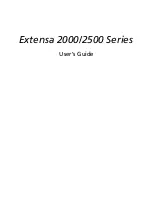
A-1
CPU (Central Processing Unit)
The CPU, sometimes called “Processor,” actually functions as the “brain” of the computer. It
interprets and executes program commands and processes data stored in memory.
Device Driver
A device driver is a special set of instructions that allows the computer’s operating system to
communicate with devices such as VGA, audio, Ethernet, printer, or modem.
DVD
DVD is essentially a bigger, faster CD that can hold video as well as audio and computer data. With
these capacities and access rates, DVD discs can provide you with dramatically-enhanced high-color,
full-motion videos, better graphics, sharper pictures, and digital audio for a theater-like experience.
DVD aims to encompass home entertainment, computers, and business information with a single digital
format, eventually replacing audio CD, videotape, laserdisc, CD-ROM, and video game cartridges.
ExpressCard
ExpressCard slot is 26 pins and support one ExpressCard/34mm or one ExpressCard/54mm expansion
card. This new interface is faster by using a serial bus supporting USB 2.0 and PCI Express instead of
the slower parallel bus used in the PC card slot. (Not compatible with previous PCMCIA cards.)
Hardware
Hardware is a general term referring to the physical components of a computer system, including
peripherals such as printers, modems, and pointing devices.
IDE (Integrated Drive Electronics)
IDE devices integrate the drive control circuitry directly on the drive itself, eliminating the need for a
separate adapter card (in the case for SCSI devices). UltraDMA/66 or 100 IDE devices can achieve up
to 33MB/Sec transfer.
IEEE134 (134)
Also known as iLINK (Sony) or FireWire (Apple). 1394 is a high speed serial bus like SCSI but
has simple connections and hot-plugging capabilities like USB. The popular 1394a interface has a
bandwidth of 400Mbits/sec and can handle up to 63 units on the same bus. The newer 1394b interface
can support twice the speed and will appear in future models when peripherals support higher speeds.
1394 is also used in high-end digital equipment and should be marked “DV” for Digital Video port.
Kensington
®
Locks
Kensington
®
locks (or compatible) allow the Notebook PC to be secured usually using a metal cable
and lock that prevent the Notebook PC to be removed from a fixed object. Some security products
may also include a motion detector to sound an alarm when moved.
Glossary (Cont.)
Appendix
A
















































